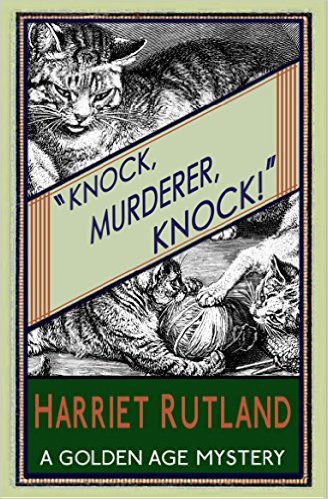Bear with me, readers! I have to save a friendship!
I’ve been blogging for ten months now, and I have enjoyed bobbing up and down at the fringes of a circle of powerful people who write about vintage mysteries. They are a complex and interesting bunch, and I enjoy our interactions, no more so than with my two best buds, JJ and Kate.
We’re kind of like the Three Musketeers, Kate, JJ, and I, and there’s no end to the sort of mischief we get into: sharing a rowdy pint at JJ’s local pub, The Judas Window, where we get down to a serious competition over darts (I always bring the board with Paul Halter’s face taped on the front); saddling Kate’s pygmy goats and riding to the side of the local highway, hooting raucously at any hard-boiled crime fans who drive past; plotting fifty good ideas before breakfast on how to get Donald Trump to disappear forever.

And now, it’s all falling apart. Kate and JJ have come to blows over an Irish writer named Eilís Dillon, specifically over Death at Crane’s Court, the first of only three mysteries she wrote. Kate, who publishes the blog Cross Examining Crime, is a fan of Dillon’s characterization and praised the setting and plot of the book here. JJ, well known for his forays into the world of locked room mystery fiction at his site, The Invisible Event, was appalled at Dillon’s callous portrayal of the elderly in his review here. Ultimately, my two former comrades-in-arms declared war on each other, and our regular Saturday night bridge games (where we bet on who could sneak out as dummy and jab Kate’s sister with a hatpin without being caught) effectively came to an end.

Damn you, Eilís Dillon!
It thus became incumbent on me to read Death at Crane’s Court and resolve this emotional brouhaha in order to restore peace to the Musketeers! Luckily, I had already purchased the novel while in New York, and so I vowed to make this refereeing job my top priority. JJ and Kate have both agreed to abide by my word so that we can resume coming up with flavor names for my ice cream shoppe for mystery lovers (Ngaio Marshmallow, anyone?)
I have to reveal my own prejudices here, and they include the outward similarity between Dillon and Harriet Rutland, who also only wrote three mysteries and who similarly set her first one at a residential hotel catering primarily to the old and the infirm. I absolutely loved Rutland’s Knock, Murderer, Knock as I discussed here. In fact, my biggest disap-pointment was that Rutland only had three books to her credit, so I am parceling out my experience as stingily as possible. The question is, does Death at Crane’s Court make me want to do the same with Dillon? Since it turns out that the tone of both books and the nature of the cases themselves are so different that they beggar comparison, I’m forced to consider Dillon separately from Rutland and to make my judgments from this book alone.
 This is a great book!!!
This is a great book!!!
The novel is subtitled “An Irish Mystery,” and I wonder if there is something about this fine culture that informs the book as we read it. I don’t want to talk in clichés, but one often hears the idea of “fey” bandied about when it comes to the Irish. That certainly could be borne out by Dillon’s book since the residents of the hotel where the action is set are, for the most part, fey to the nth degree! Yes, JJ is entirely correct in his review when he informs you that Dillon has included a Major who shot his cook to death for making the sprouts too watery and a little old lady who murders her cats to use as fertilizer for her garden. The hotel is a hotbed of viciousness and gossip amongst its mostly elderly crowd, as well as people with the most cockamamie schemes, like the nasty old harridan with the loser son that she wants to foist off on the beautiful owner of the hotel, figuring that a widow will marry anybody. But Dillon is making a point – one that Rutland also made in her book – that people with too much time on their hands, or those who are vastly absorbed in their own ill health or problems, will slowly rot on the inside. The young protagonist of Crane’s Court, George Arrow, actually observes this happening to himself when he arrives to stay after a diagnosis of a serious heart problem, and Dillon suggests this was to be expected:
“It was so easy there to believe that his own comfort, the very angle of his chair and the temperature of his room, were important. Everyone took for granted that he would be selfish, particular and critical of what was done for him . . . He began to develop silly likes and fancies, to arrive for meals at the same moment every day, and to be impatient of the smallest delay in the service.”
George is only thirty-six when this transformation takes place, and while JJ complains of Dillon’s tendency to dismiss the elderly with spurious tags of eccentricity, he would have to admit that the younger characters have similar quirks. As a major character, George turns out to be a more wholly-rounded character by the end, as does the elderly Professor Daly, an amusing man with the dreaded secret that he writes bad but successful romance novels under the name Rosemary Downes and who seems perfectly willing to let someone get away with murder if the victim’s death has improved everyone’s standard of living.


Meanwhile, Kate places much of her appreciation for Dillon’s powers of characterization on the two prominent female characters: the scheming receptionist Eleanor Keane and the lovely – but is she too good to be true? – Barbara Henry, the hotel owner, who seems to make every man want to marry her. I enjoyed both these characters, although I couldn’t help thinking about characters like Mrs. Dawson, the mystery novelist, or Mrs. Napier, the angry old lady, in Knock, Murderer, Knock. Both these women – indeed, all the characters in Rutland’s novel – seemed both funnier and more complex and realistically drawn. I also felt that the depiction of both Barbara and Eleanor reflected the inherent sexism of 1950’s society, and I was a little surprised by that considering that the author was a woman. Even though Mike makes several references to the ridiculousness of the idea that a widow is always prime for remarriage – and not choosy about it – the men here all tend to consider the women on the basis of their attraction or lack thereof. And the women either wrap themselves up around their men or are victimized by men and basically just take it. Barbara’s actions regarding her son reflect this and made no sense to me even after the novel was over. The women in Rutland’s novel seemed stronger in mind and spirit, more in control of their own fates.
 Did I mention that you should read this???
Did I mention that you should read this???
Oh, but there I go! I promised not to compare. I liked the people in Dillon’s book. I liked the setting, and I enjoyed the gentle humor, especially Professor Daly’s and that of Inspector Mike Kenny, Daly’s friend from the Guard who comes to solve the case. I shuddered at the story of Mrs. Fennell, the cat murderess, but at least this situation does end up bearing some significance to the actual murder plot.
And speaking of plot, here’s where I fear I begin to choose clearer sides. JJ didn’t speak much about the investigative aspects of the plot, while Kate suggested that the choice of murderer and motive were “well-chosen, complex but plausible.” I would venture to say that Death at Crane’s Court would not please those who love a good puzzle mystery since there really is no puzzle element present. It reads much more like a police procedural, dependent completely on the interviews Mike has with the various characters in and around the hotel. Through them, he determines many motives, and he creates a timeline, which suggests that nearly everyone visited the victim on the day of his death. There really are no clues per say, neither physical nor verbal ones, and at the end I couldn’t help feeling that Mike had pretty much guessed his way to the correct solution.
That said, I spotted the murderer immediately. I didn’t understand the killer’s reasons, but then nobody could have because we get no information necessary ahead of time to figure that out. I just knew. It may be a gift, or it may be that, for reasons I will only discuss privately or in the comments below in order not to spoil things for potential readers, this person stood out by a mile. And so, like the characters, the mystery itself becomes a little bit “fey.”
An introduction about Dillon, written by her daughter Cormac Ó Cuilleanáin, is included in the book. In it we learn that Dillon was of a highly literary mind and perhaps sought to “elevate” mysteries with fine writing. (She appreciated Christie’s plots but would not have her books in the house due to their simplistic style, preferring instead Sayers, Allingham and Chesterton.) Crane’s Court tends to reflect this, paying little heed to unimportant matters of clueing and suspense over style and characterization. I did pick up another Dillon in New York, Death in the Quadrangle, and I look forward to reading it, although not as much since I read Kate’s warning that it’s detection is not as strong as in the first book. (According to her daughter, it was in Dillon’s middle mystery, Sent to His Account, that she really excelled at puzzle-building.)
Meanwhile, I’ll take this moment once again to highly recommend Harriet Rutland to you all on the strength of a debut mystery that – okay, I have to say it – beats out Dillon’s first effort in every capacity by a mile!
Don’t be mad at me, Kate. And please make it up to JJ. We’ll let you be dummy!!! Here, you want a bowl of Rum Raisin Chandler? JJ, where are the darts . . . ?
Oh well, at least I have Bev on my side so I don’t feel quite so alone. Interesting that Sent to his account is the most puzzle-focused – have to see when I read it for Rich’s challenge. Wonderful post and I especially liked the comparisons to Knock Murderer Knock, which I wouldn’t have said was better and like you in this book, I spotted the murderer incredibly early on. Have you read Blue Murder? That is Rutland’s best book in my opinion. Not sure the goats will be keen on being ridden but how about having a polish chicken perching on your shoulder like a pirate’s parrot instead?
LikeLiked by 1 person
And yes I imagine JJ is very chuffed at the moment…
LikeLike
I’ll take the parrot, Kate, as long as we can train it to reveal the killer’s name in each Paul Halter novel! Wouldn’t it be great to have a bird who could lean over a reader’s shoulder and squawk, “They all did it! They all did it!”
LikeLiked by 1 person
Hmm well I’ll see if Fudge (the best chicken for doing pirate parrot impersonations) has any aptitude for spotting fictional killers. Though it has to be said she’s not the sharpest tool in the shed.
LikeLike
Thanks for the review, and I think it has helped me to decide against buying a copy, and waiting for someone to review ‘Sent to His Account’. I fear there are more storm clouds threatening to divide the Musketeers… How about some posts on Christie versus Carr?? 😛
LikeLiked by 1 person
Impossible to truly debate two authors when you adore both of them!
LikeLike
I didn’t read the introduction — I was too frustrated after reading the book itself — but anyone who won’t even have Christie’s books in their house because of her “simplistic style” really has no business claiming they’re capable of “elevating” the genre. How pompous, ignorant, conceited, and misguided, especially when you then produce something as substandard as this as your response. Knowing this makes me like the book even less!
Also, I’ve told you: I couldn’t make the Bridge Evening last Saturday because I had a flat tire. I was able to pull my car into nearby woodland and spent several hours stuggling with the spare because I had no mobile phone reception and it was raining so I didn’t want to walk anywhere for help. I can’t help that my wealthy uncle who left me everything in his will was battered to death inside a locked and bolted safe inside his locked, bolted, and barred study inside the locked, bolted, barred, and hermetically sealed east wing of his country mansion, some twenty minute walk from where I was parked. Besides, I’m fairly sure it was Kate’s fingerprint that they found on the door handle. I, er, imagine…
LikeLiked by 2 people
haha I didn’t think in your victor’s speech you would be framing me for murder!
LikeLiked by 2 people
It’s only a frame if it’s not true, Kate.
LikeLike
What would my motive be for murdering your uncle?
LikeLike
Well, clearly because you’re currently on the jury for a big murder case and my uncle was called in as an expert witness. He definitely had the defendant to afternoon tea on the day of the murder, and so was able to provide an alibi…but then you remembered that, since my uncle is a master close-up magician, he was actually hired to entertain the guests at a wedding where you were present at the time he claimed to be having tea with the accused!!. You didn’t recognise him at first because obviously he a) wears make-up in his professional role and b) goes by the stage name of McMurnahan the Mulleted Multi-Tasking Master Magciain (and Manicurist of Miniature Marsupails). Your sense of social injustice was so great — you once had an afro’d chicken that was wrongly convicted following false testimony from a crafty fox — that you followed him home and accidentally killed him while insisting he change his testimony.
What you don’t realise is that he’s an alcoholic and has the shakes quite badly, so hasn’t been able to perform his prestidigitations for some years now. As a result, he’s been farming out the McMurnahan name and allowing other people to take his place (hence the make-up) and so it wasn’t actually him at the wedding!!!. Of course, if he admits this then he’ll be sued, and his person debts are so great that he can’t afford this (hence the need for this subterfuge in the first place — his marsupial manicure parlour burned down last year and, due to an insurance loophole, he couldn’t get a payout and so nearly lost everything).
See, this is what happens when you act recklessly, Kate. I hope you’ve learned your lesson.
LikeLiked by 1 person
It’s moments like these which give brief windows into what it’s like inside your head. Miniature Marsupial Manicure parlour? Pure gold. Sure koala bears love having their nails painted. With such creative flair you ought to write a comic crime novel.
LikeLike
Motive, shmotive! The only question here is if Katy didn’t . . . or Katydid!!!!!
LikeLiked by 1 person
Great review, you really made me laugh. What a peacemaker you are…(??)
For my ice-cream may I have two flavours Marb/pled together? I think it will be a Towards Zero-calorie dessert.
LikeLiked by 1 person
Excellent option, Moira, especially since the menu already includes a high calorie sundae option (ten scoops of ice cream slathered with triple fudge, macadamia nuts, brandied cherries and enough whipped cream to choke the cow it came from) called So Many Steps to Death.
LikeLike
Pingback: Sent to his Account (1954) by Eilís Dillon | crossexaminingcrime